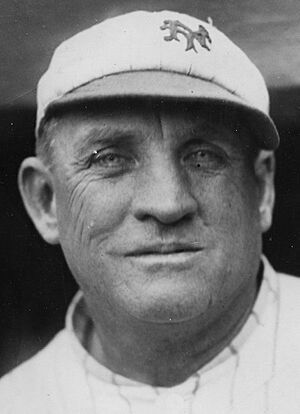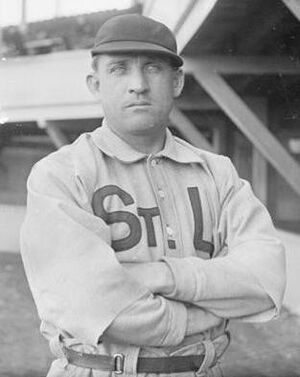Jesse Burkett facts for kids
Quick facts for kids Jesse Burkett |
|||
|---|---|---|---|

Burkett in 1920
|
|||
| Left fielder | |||
| Born: December 4, 1868 Wheeling, West Virginia, U.S. |
|||
| Died: May 27, 1953 (aged 84) Worcester, Massachusetts, U.S. |
|||
|
|||
| debut | |||
| April 22, 1890, for the New York Giants | |||
| Last appearance | |||
| October 7, 1905, for the Boston Americans | |||
| MLB statistics | |||
| Batting average | .338 | ||
| Hits | 2,850 | ||
| Home runs | 75 | ||
| Runs batted in | 952 | ||
| Teams | |||
|
|||
| Career highlights and awards | |||
|
|||
| Induction | 1946 | ||
| Election Method | Old-Timers Committee | ||
Jesse Cail Burkett (December 4, 1868 – May 27, 1953) was a famous American baseball player. People called him "Crab" because he was very serious and sometimes argued a lot. He played as a left fielder in Major League Baseball (MLB) from 1890 to 1905. He played for teams like the New York Giants, Cleveland Spiders, St. Louis Perfectos / Cardinals, St. Louis Browns, and Boston Americans.
Burkett was an amazing hitter. He batted over .400 twice, which is very rare! He also held the record for the most hits in a single season for 15 years. After he stopped playing, he became a manager in the minor leagues. In 1946, he was chosen to be in the National Baseball Hall of Fame, which is a huge honor for baseball players. He also holds the record for the most inside-the-park home runs in MLB history, with 55! He was also known as one of the best players at bunting the ball.
Contents
Early Life and Baseball Start
Jesse Burkett was born in Wheeling, West Virginia. His father worked for a bridge company. Jesse started his professional baseball career as a pitcher when he was only 19 years old. In 1888, he won 27 games for the Scranton Miners. The next year, he had an amazing record of 39 wins and only 6 losses for the Worcester Grays.
He got his nickname, "Crab," because he was very serious. He was also known for arguing with sportswriters, umpires, and other players.
Jesse Burkett's Baseball Career
Starting in the Major Leagues
Jesse Burkett joined Major League Baseball in 1890 with the New York Giants. He started as a pitcher, but it didn't go well. He won 3 games and lost 10. However, he was a great hitter right away! He batted .309, which was the second-best on his team.
In 1891, he moved to the Cleveland Spiders. He played most of that year in the minor leagues, where he batted .316. He joined the Spiders for the last part of the 1891 season and stayed with them until 1898. In 1892, his batting average was .275. He was also one of the top players in runs scored and triples. The next year, his batting average jumped to .348. He also got 98 walks, which means he was good at getting on base. He often ranked high in walks throughout his career.
Jesse wasn't known for being a great fielder. In 1893, he made 46 errors, which was the most in the league for outfielders. He tried to improve his fielding with help from another player, Jimmy McAleer. Still, he often made many errors and has one of the highest error counts for an outfielder in baseball history.
Amazing Hitting: Batting Over .400
In 1895, Jesse Burkett had an incredible season. He batted .405 and led the National League in batting average. He also led the league in hits with 225. The next year, he did even better, batting .410! He led the league in batting average, hits (240), and runs scored (160). His 240 hits were a major league record for 15 years.
Jesse Burkett was only the second player in baseball history to bat over .400 twice. The Cleveland Spiders finished second in 1895 and 1896. They played against the Baltimore Orioles in the Temple Cup series both years. The Spiders won the Temple Cup in 1895.
In 1897, Jesse was hit in the head by a pitch and was knocked out. He missed two weeks but came back strong. Later that season, he got into a big argument with an umpire and was thrown out of two games in one day! He refused to leave the field, and police officers had to remove him. Despite this, he still finished third in batting average that year.
Moving to St. Louis and Later Years
By the end of 1898, the Cleveland Spiders were having money problems. Their owner, Frank Robison, bought the St. Louis Cardinals. In 1899, Jesse Burkett and his teammate Cy Young moved from the Spiders to the St. Louis Perfectos. Jesse played for the Perfectos/Cardinals for three seasons.
In 1901, he led the National League again in batting average (.376). He also led in on-base percentage (.440), hits (226), and runs scored (142). This was the third time he led the league in batting average!
Before the 1902 season, Jesse joined the St. Louis Browns in the American League. He batted over .300 for the last time in his career that year. The next year, a new rule started where foul balls counted as strikes. This made it harder for hitters, and his batting average dropped below .300 for the first time since 1892. His batting average continued to fall in the following years.
In 1905, he was traded to the Boston Americans. This allowed him to be closer to his home in Worcester. His play continued to decline, and he retired at the end of the season. At that time, he had the second-most career hits in baseball history. He still holds the record for the highest batting average (.378) and on-base percentage (.444) in St. Louis Cardinals history.
Life After Playing Baseball
After retiring as a player, Jesse Burkett became a manager. He managed the Worcester Busters in the New England League from 1906 to 1915. He even played in some games for the team. In 1906, he led that league with a .344 batting average.
In 1916, he started coaching baseball at the College of the Holy Cross. In four seasons coaching the Holy Cross Crusaders, his teams had an amazing record of 88 wins, 12 losses, and 1 tie. Nine players from his 1919 team were chosen as All-East players.
Burkett continued to manage in the minor leagues until 1933. In 1946, he was elected into the National Baseball Hall of Fame. He was the first person from West Virginia to be inducted into the Hall of Fame.
Jesse Burkett passed away in Worcester, Massachusetts, on May 27, 1953.
See also
- List of Major League Baseball career batting average leaders
- List of Major League Baseball career on-base percentage leaders
- List of Major League Baseball career hits leaders
- List of Major League Baseball career triples leaders
- List of Major League Baseball career runs scored leaders
- List of Major League Baseball career stolen bases leaders
- List of Major League Baseball players with a .400 batting average in a season
- List of Major League Baseball batting champions
- List of Major League Baseball annual runs scored leaders


